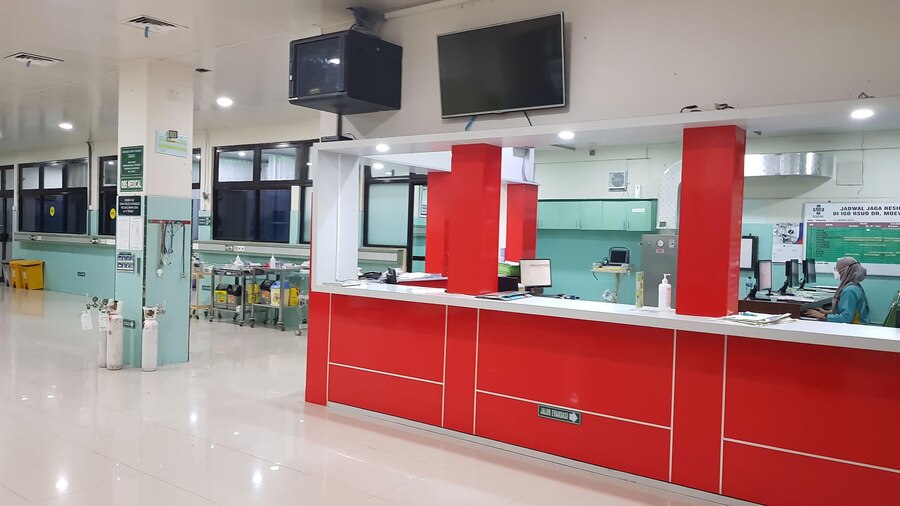A hospital nurse station is a critical hub within any healthcare facility, serving as the center for patient care coordination, staff communication, and vital clinical decision-making. Positioned strategically in patient care units, these stations are often the first point of contact for anyone in need of assistance or information, whether it’s a patient, family member, or another healthcare professional. They play a vital role in patient safety, operational efficiency, and staff workflow. Here’s a detailed look at the functions, challenges, design considerations, and technological advancements involved in hospital nurse stations.
1. Functions and Purpose of a Nurse Station
The primary purpose of a nurse station is to coordinate patient care efficiently. Nurse stations function as the main communication link between doctors, nurses, and patients, helping streamline patient information, treatments, and care plans. They typically handle various tasks, including:
-
Patient Monitoring and Management: Nurse stations are where nurses monitor patient status and update their records. From here, they can track medications, follow up on test results, and keep a close eye on patients with more critical needs.
-
Communication Center: The station enables communication between healthcare providers and acts as an information point for patients and families. Nurses relay information between doctors and patients, ensuring that vital information is shared promptly.
-
Documentation and Record Keeping: Nurses are responsible for extensive documentation, including noting vital signs, recording patient histories, and updating treatment progress. These records are crucial for coordinated care and compliance with legal and regulatory requirements.
-
Supply and Equipment Management: Many nurse stations keep essential supplies, like IV fluids, gloves, and sanitizers, within easy reach, ensuring that healthcare staff have quick access to necessary tools.
-
Coordination of Care Plans: Nurse stations act as a central point for coordinating multidisciplinary care plans, bringing together professionals from various specialties to ensure comprehensive patient treatment.
2. Design Considerations for Nurse Stations
The design of a nurse station can significantly impact the efficiency, morale, and overall quality of care in a hospital. A well-designed nurse station minimizes physical strain, reduces noise, and improves access to resources, all of which are essential for delivering optimal patient care. Key design elements include:
-
Visibility and Proximity to Patient Rooms: For patient safety, nurse stations should have good visibility and be close to patient rooms, especially in intensive care or emergency units. This layout allows nurses to monitor patients directly, respond faster to emergencies, and maintain a quieter environment.
-
Ergonomic Design: Nurses spend long hours at these stations, often transitioning from paperwork to computer screens and moving between multiple tasks. Ergonomic furniture and adjustable seating reduce fatigue and prevent injuries associated with prolonged standing or poor posture.
-
Accessibility and Workflow Efficiency: Stations should be designed with an intuitive layout, with items used frequently (like charts, phones, and computers) within easy reach. Efficient workflow reduces the time nurses spend searching for materials and supplies.
-
Noise Reduction Measures: A noisy environment can increase stress levels and negatively affect both patients and staff. Design features like acoustic panels, carpeting, and separate spaces for conversations can help reduce noise levels in and around the station.
-
Technology Integration: Nurse stations increasingly rely on technology to streamline their work. This includes incorporating computer systems, mobile devices, and electronic health records (EHRs) in ways that are easy to access and use without causing clutter.
3. Challenges Faced at Nurse Stations
While nurse stations are crucial to the functioning of any healthcare setting, they also come with unique challenges that can impact both patient care and staff well-being. Common issues include:
-
Workload and Staffing Pressures: Nurse stations are often understaffed, placing additional pressure on available nurses to multitask and take on responsibilities beyond their capacity. This can lead to errors, staff burnout, and a decrease in the quality of patient care.
-
Communication Overload: A nurse station handles multiple communication streams, including calls from doctors, alerts from patient monitoring systems, and questions from family members. Managing these efficiently without overlooking any vital information is challenging.
-
Physical Space Constraints: Limited space can make it difficult to organize supplies, access records, and communicate without distraction. Overcrowded stations contribute to inefficiency and can exacerbate stress among staff members.
-
Technological Barriers: Not all nurse stations are equipped with up-to-date technology. Outdated systems or inconsistent access to EHRs and other digital tools can make it difficult for nurses to retrieve or document patient information quickly and accurately.
-
Infection Control: Nurse stations need to be designed with infection control in mind. With staff frequently moving between patients, the stations themselves can become sources of cross-contamination if proper sanitization protocols aren’t followed.
4. Technological Advancements and Innovations
Technology plays a pivotal role in enhancing the efficiency of nurse stations, ensuring that they evolve to meet the growing demands of modern healthcare. Some notable advancements include:
-
Electronic Health Records (EHRs): EHR systems enable real-time updates on patient status and allow healthcare providers to access records instantly. This reduces reliance on physical charts and minimizes errors caused by outdated information.
-
Automated Medication Dispensing Systems: These systems streamline medication management by providing secure access and tracking usage, minimizing the risk of medication errors.
-
Smart Communication Tools: Advanced communication tools, such as pagers and mobile devices equipped with specialized healthcare apps, allow nurses to connect instantly with other healthcare providers, receive alerts, and access patient records remotely.
-
Real-Time Location Systems (RTLS): RTLS technology helps track the location of equipment, staff, and even patients within the facility. This can be particularly useful in large hospitals where finding equipment or reaching a colleague quickly is essential for patient care.
-
Telehealth Integration: Telehealth capabilities are being integrated into nurse stations, allowing for remote consultations with specialists and enabling nurses to manage patient care more comprehensively, especially in rural or underserved areas.
5. The Role of Nurse Stations in Enhancing Patient-Centered Care
A well-managed nurse station is central to delivering patient-centered care, where the focus is on treating patients as individuals with unique needs. Nurse stations facilitate this approach in the following ways:
-
Improving Patient Accessibility: By acting as a communication hub, nurse stations ensure that patients and families have access to information and support, enhancing the overall patient experience.
-
Facilitating Care Coordination: Nurse stations are key in coordinating a patient’s journey through the healthcare system, from admission to discharge. Effective coordination ensures that each patient receives tailored, high-quality care based on their unique medical needs.
-
Reducing Response Times: The proximity of nurse stations to patient rooms and critical care areas helps reduce response times during emergencies, improving patient outcomes.
-
Building Relationships with Patients and Families: Nurse stations act as touchpoints where patients and families can voice concerns, ask questions, and feel reassured, building trust and confidence in the care being provided.
6. Future Trends in Nurse Station Design and Functionality
With healthcare constantly evolving, nurse stations are likely to see new trends and advancements in the coming years, including:
-
Mobile and Decentralized Nurse Stations: Some hospitals are experimenting with decentralized nurse stations, where smaller, mobile stations are positioned closer to patient rooms. This approach enables a more hands-on, patient-centered model of care.
-
Smart Stations with Predictive Analytics: Using predictive analytics, nurse stations could soon analyze data in real-time, predicting when a patient is at risk of deteriorating, scheduling staffing based on anticipated demand, or identifying trends in patient admissions.
-
Sustainability in Design: As healthcare facilities strive for eco-friendly solutions, nurse stations are beginning to incorporate sustainable design principles, like using energy-efficient lighting, eco-friendly materials, and optimized layouts to reduce waste.
Conclusion
The hospital nurse station is more than just a desk; it’s a nerve center that supports the delivery of safe, efficient, and compassionate patient care. From streamlining communication and documentation to managing complex workflows and improving response times, nurse stations play a critical role in the healthcare system. With the right design, technology, and focus on patient-centered care, nurse stations can continue to support nurses, enhance patient satisfaction, and evolve alongside healthcare advancements.




